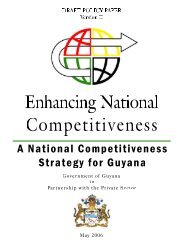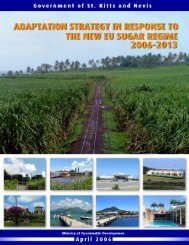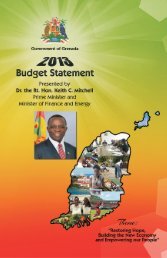Business Removing
Doing Business in 2005 -- Removing Obstacles to Growth
Doing Business in 2005 -- Removing Obstacles to Growth
- No tags were found...
Create successful ePaper yourself
Turn your PDF publications into a flip-book with our unique Google optimized e-Paper software.
86 DOING BUSINESS IN 2005<br />
Enforcing contracts<br />
Indicators on enforcing contracts measure the efficiency of<br />
the judicial (or administrative) system in the collection of<br />
overdue debt. The data are built following the step-by-step<br />
evolution of a payment dispute either before local courts or<br />
through an administrative process, if such a process is available<br />
and preferred by creditors. The data are collected<br />
through research of the codes of civil procedures and other<br />
court regulations, as well as surveys to local litigation lawyers.<br />
At least 2 lawyers participate in each country and in a quarter<br />
of the countries, judges complete the survey as well. To ensure<br />
comparability, survey respondents are provided with significant<br />
detail, including the amount of the claim, the location<br />
and main characteristics of the litigants, the presence of city<br />
regulations, the nature of the remedy requested by the plaintiff,<br />
the merit of the plaintiff’s and the defendant’s claims and<br />
the social implications of the judicial outcomes.<br />
Assumptions about the case<br />
To make the case comparable across countries, 10 assumptions<br />
are employed:<br />
• The debt value equals 200% of the country’s income per<br />
capita.<br />
• The plaintiff has fully complied with the contract (the<br />
plaintiff is 100% right).<br />
• The case presents a lawful transaction between businesses<br />
residing in the country’s most populous city.<br />
• The bank refuses payment for lack of funds in the borrower’s<br />
account.<br />
• The plaintiff attempts to recover the debt by filing<br />
a law suit or going through an administrative process, if<br />
such a process is available and preferred by creditors.<br />
• The debtor attempts to delay service of process but it is finally<br />
accomplished.<br />
• The debtor opposes the complaint (default judgment is<br />
not an option).<br />
• The judge decides every motion for the plaintiff.<br />
• The plaintiff attempts to introduce documentary evidence<br />
and to call one witness. The debtor attempts to call one<br />
witness. Neither party presents objections.<br />
• The judgment is in favor of the plaintiff.<br />
Procedures measure<br />
The indicator measures the number of procedures mandated<br />
by law or court regulation that demand interaction between<br />
the parties or between them and the judge (or administrator)<br />
or court officer.<br />
Cost measure<br />
The indicator measures the official cost of going through<br />
court procedures, including court costs and attorney fees<br />
where the use of attorneys is mandatory or common, or the<br />
costs of an administrative debt recovery procedure, expressed<br />
as a percentage of the debt value.<br />
Time measure<br />
The indicator measures the time of dispute resolution—in<br />
calendar days—counted from the moment the plaintiff files<br />
the lawsuit in court until settlement or payment. This includes<br />
both the days where actions take place and waiting periods<br />
between actions. The respondents make separate estimates<br />
of the average duration of different stages of the<br />
dispute resolution: for the completion of service of process<br />
(time to notify the defendant), the issuance of judgment<br />
(time for the trial or administrative process) and the moment<br />
of payment or repossession (time for enforcement).<br />
The methodology is originally developed in Djankov and others<br />
(2003) and adopted with minor changes here.<br />
Closing a business<br />
Doing <strong>Business</strong> studies the time and cost of insolvency proceedings<br />
involving domestic entities. The data are derived<br />
from survey responses by local law firms, all members of the<br />
International Bar Association. Answers were provided by a<br />
senior partner at each firm, in cooperation with one or two<br />
junior associates.<br />
Assumptions about the business<br />
To make the business comparable across countries, 10 assumptions<br />
are employed. The business:<br />
• Is a limited liability company.<br />
• Operates in the country’s most populous city.<br />
• Is 100% domestically owned, of which 51% is owned by<br />
its founder, who is also the chairman of the supervisory<br />
board (aside from the founder, there is no other shareholder<br />
who has above 1% of shares).<br />
• Has downtown real estate as its major asset, on which it<br />
runs a hotel.<br />
• Has a professional general manager.<br />
• Has average annual revenue of 1,000 times income per<br />
capita over the last 3 years.<br />
• Has 201 employees and 50 suppliers, each of whom is<br />
owed money for the last delivery.<br />
• Borrowed from a domestic bank 5 years ago (the loan has<br />
10 years to full repayment) and bought real estate (the<br />
hotel building), using it as a security for the bank loan.<br />
• Has observed the payment schedule and all other conditions<br />
of the loan up to now.<br />
• Has a mortgage with the value of the mortgage principal<br />
being exactly equal to the market value of the hotel.

















